How Tax Office SF ditched paper for 10x faster billing
Tax Office SF transformed paper-heavy legacy workflows into a streamlined, digital-first operation. With Method CRM, they automated billing, centralized client data, and built a more agile, responsive firm.
Want to see it in action first? Take me there →
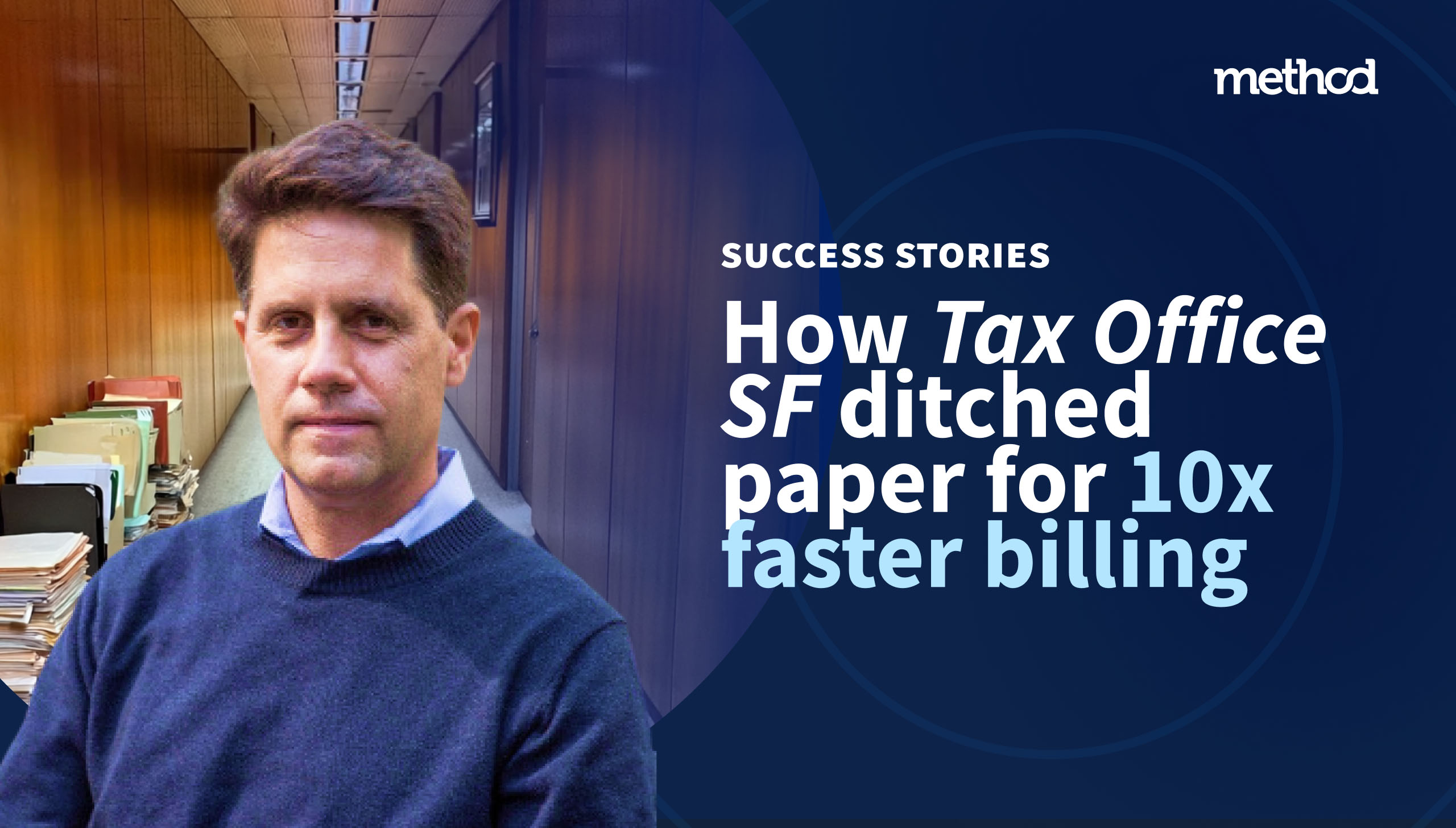
10x faster billing process
With Method and QuickBooks, Tax Office SF cut invoice prep time from 20 minutes to under 2, saving hundreds of hours annually.
Clearer cashflow insights
Online invoicing with Method gave Tax Office SF faster receivables and real-time financial visibility, enabling better forecasting.
Remote, national team
With Method’s cloud platform, Tax Office SF now recruits and collaborates with top-tier advisors across the U.S.
Tax Office SF: A tax firm eager for modernization
For over 50 years, Tax Office SF had run like a well-oiled machine. But like most tax firms, that machine ran primarily on paper, manual processes, and deep institutional knowledge.
Tax Office SF prides itself on the high-touch, boutique services that have earned them a loyal following—especially among high-net-worth individuals in the San Francisco area with complex tax needs. Tax Office SF advises on everything from highly complex transactions, to stock options, home sales. marriages, home purchases, and almost anything you can imagine.
A team of 12+, the company has three Partners at the helm: Steve Axelrod, Founder, Enrolled Agent, MBA; Richard Snow, Owner / Partner, President, Enrolled Agent; and Aaron Phillips – Owner / Partner, Enrolled Agent, Certified Estate Planner.
The company has found success with their model—but as the industry evolved, cracks in their process began to show.
“The whole industry is changing,” explains Aaron Phillips, Partner at Tax Office SF. “All tax advisors are feeling a little bit overwhelmed with the sheer volume of requests that are coming in from clients and the IRS.”
But maintaining the high level of service their clients had come to expect was critical. That meant undertaking a major operational and technological upgrade, backed by Method.
The challenge: Manual processes in a rapidly changing industry
Tax Office SF had built a successful practice, but by the late 2010s their paper-based processes were struggling to keep up with a rapidly evolving tax landscape. And as client complexity and IRS scrutiny increased, so did the pressure to modernize.
Rising demand, limited capacity
With tax laws becoming more complex and nuanced across the country, clients needed more guidance, more often.
“The IRS is learning to use computers. That means we’re going to see a big jump in audits and the IRS sending out letters to people asking questions because now they have that data.” — Aaron Phillips, Owner & Partner @ Tax Office SF
With roughly 1,500 returns to file each year, plus year-round advisory needs, Tax Office SF’s old system was simply not adequate anymore.
Tax complexity outpacing paper
As more clients formed LLCs, S-Corps, and partnerships, the firm’s calendar filled with multiple deadlines and compliance touchpoints. In the past, a system of colored tape on paper folders was enough to manage every file, but now it was becoming all too easy to miss something.
When tax laws changed during COVID, the true limitations of this work model began to show.
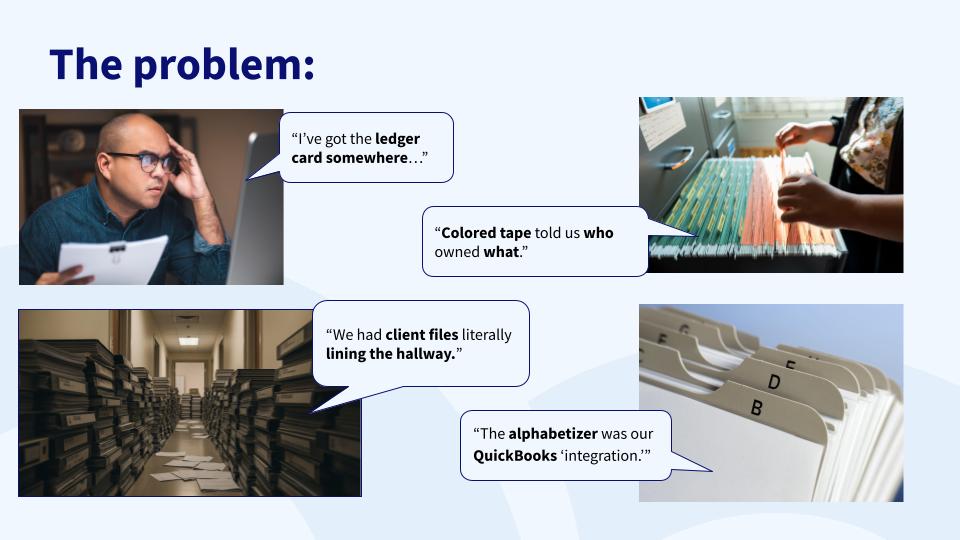
“We had hundreds of client files lined up down the hallway,” recalls Aaron. “You can’t manage a business like that.”
Disconnected systems and financial blind spots
Legacy systems at Tax Office SF weren’t just impacting client files—they also took a toll on internal business management.
Until recently, every client’s billing record lived on a handwritten ledger card, filed alphabetically in a physical card catalog. Payments were taken by phone or check, then entered manually into QuickBooks using “the alphabetizer”.
While using this method worked in practice, it had its limitations. There was no way to track revenue or cash flow across the company in real time, and workflows remained manual and siloed. Financial planning was, as Aaron described, akin to “dead reckoning.”
“We very happily shelved the alphabetizer just six months ago, primarily thanks to Method,” explains Aaron.
No centralized way to collaborate
With client information stored in paper files and billing data logged separately, there was no single system that provided a clear, up-to-date picture of a client’s status. Most internal workflows relied on physical handoffs, hallway conversations, and ad hoc email updates.
“If someone had the file, they knew,” Aaron explained. That meant tax advisors couldn’t easily pick up where someone else left off—or jump in to help when deadlines loomed.
This fragmentation made remote work virtually impossible. When COVID hit, it exposed just how dependent the team was on in-office access and in-person communication. Staff couldn’t collaborate asynchronously or keep client records current across the team.
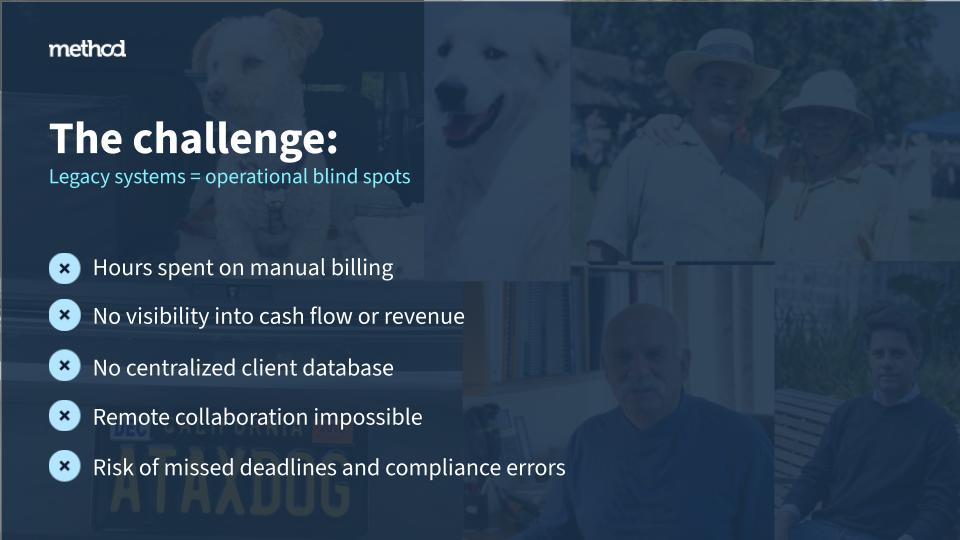
Their previous CRM integrated with their tax software, but not QuickBooks, which is the standard billing and payments platform for organizations in this industry. This left billing and client service in disconnected systems and limited visibility across the business.
What the team needed was more than just digitization. They needed a central source of truth that brought client service, billing, and internal workflows together in one platform.
The solution: A tailored CRM built to modernize tax operations
When the team at Tax Office SF finally decided “enough is enough,” they weren’t just looking for a CRM. They needed a platform that could bring their operations into the 21st century without disrupting the personalized client service that defined their firm.
A system that fits the firm, not the other way around
After evaluating multiple options, Method CRM quickly rose to the top. Unlike previous systems they’d tried, Method checked two critical boxes: native QuickBooks integration and deep customizability.
“Because of the Method relationship and that direct sync to QuickBooks, we’ve been able to automate the whole billing process. That was a game-changer.”
— Aaron Phillips, Owner & Partner @ Tax Office SF
Instead of forcing their office to fit a rigid CRM structure, Method offered a platform they could mold to their workflows.
A true collaboration with the Method team
Implementing the Method wasn’t a solo effort. From day one, Tax Office SF worked hand-in-hand with Method’s services team to build a CRM that worked for their unique needs.
“Between our team, we’ve added on all of these different features,” says Aaron. “We’ve worked with [Method’s] staff to help build and deploy just what we needed.”
This collaborative build included everything from workflow screens and custom reports to advanced billing and client segmentation tools. It allowed Tax Office SF to incrementally add functionality while keeping the platform simple and intuitive for their team.
One step at a time, starting with billing
The rollout began where the pain was greatest: invoicing.
Previously, billing relied on handwritten ledger cards and phone calls. With Method, they launched QuickBooks-integrated invoicing that let clients pay online with just a click. Once payments were made, the CRM automatically recorded the payment against the client file.
“In the past, a client would have to call in to make a payment… you’d have a receptionist’s time and a bookkeeper’s time spent on each payment,” Aaron explains. “Now a client can simply click on an invoice and pay, and it’s automatically in QuickBooks.”
With that success, the team expanded Method’s use to client onboarding, task tracking, workflow management, and secure document storage.
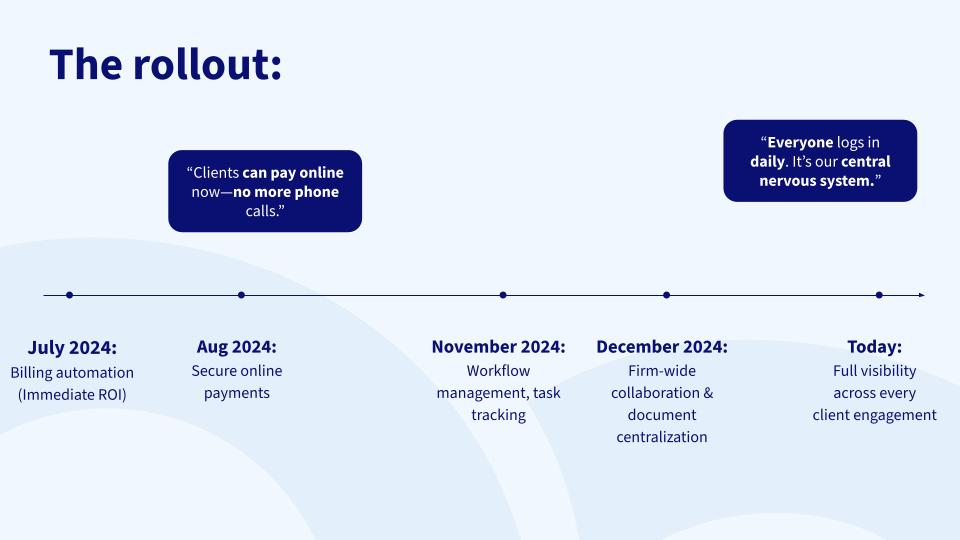
Designed for how they work
Unlike cookie-cutter CRMs, Method became the central nervous system for Tax Office SF. tracking every client, task, note, and payment in one place.
“We use it to track files, to assign things to different people within the firm,” said the team. “Every day, everybody gets logged in and they use it. That’s how we track all of the clients.”
And because it’s cloud-based, the team can now work from anywhere. Advisors across the country log in daily, update notes, and pick up tasks in real time—something that used to require endless emails and calls.
Built for today, ready for tomorrow
Method CRM didn’t just digitize Tax Office SF’s legacy systems. It truly transformed them and ensured that their team was ready for what was to come in the future. The team worked carefully to avoid creating a “digital monster” and instead focused on thoughtful workflows, clean data migration, and staff training.
The result? A CRM that feels tailor-made, evolves with their needs, and continues to unlock efficiency across the firm.
“The reality is, with Method, we’ve been able to create a very customized product that we can use in our business,” Aaron concluded.
The outcome: a leading tax firm brought into the digital age
Today, Tax Office SF is operating with a level of speed, accuracy, and confidence that would have been unthinkable just a few years ago. With the Method deployment, the firm has effectively reshaped how the office does business.
Faster billing, faster payment
Thanks to Method’s QuickBooks integration, invoicing now happens with a few clicks, and clients pay just as fast. Revenue that once trickled in over weeks or months now arrives within days.
“Revenue started coming in a lot quicker,” Aaron notes. That cash flow lift gave the firm more financial flexibility and freed up partners from chasing payments.
Hours reclaimed, errors eliminated
Before the Method, staff spent hours handwriting ledger cards and updating spreadsheets. Now, tasks that used to take 20 minutes—like billing—take less than two.
“All of this manual stuff is now gone, and it’s just automated,” Aaron explains. Fewer manual steps mean fewer errors, too. With centralized data and synced systems, nothing falls through the cracks, making client management easier, more reliable, and better for customers.
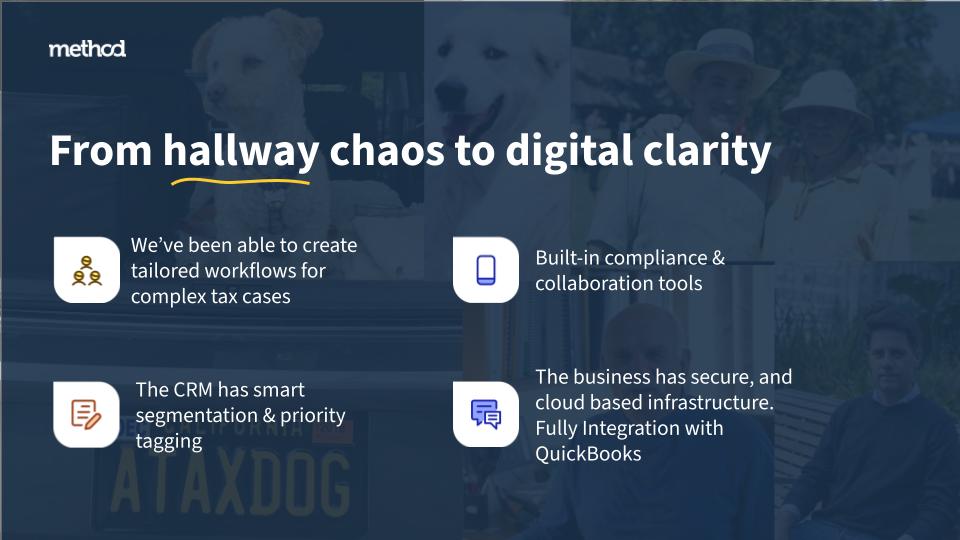
Smarter planning and proactive insights
With real-time data in Method, the team now forecasts cash flow, segments clients by need, and proactively addresses tax changes.
“If a new law affects 100 clients, we can filter, assign, and track that process instantly,” Aaron says. No more hallway file piles, and a substantially increased capacity to flag and react to tax law changes based on client location, business type, and a multitude of other factors that might impact their tax profiles.
A national, fully integrated workforce
Going digital unlocked a national talent pool for Tax Office SF that’s connected at all times through Method. Tax advisors across the country now log into Method daily, fully embedded in workflows. Client files and tasks can be securely assigned to advisors in seconds, along with pre-defined workflows and context libraries tailored to each customer.
“We can recruit top-tier talent from anywhere,” emphasizes Aaron. Method makes it seamless to assign, collaborate, and track client progress, no matter where the team is.
Modernizing without compromising: the Tax Office SF way
In just a few years, Tax Office SF transformed from a paper-bound practice into a streamlined, cloud-based operation, without losing the high-touch service that their 50-year firm was built on.
With Method CRM at the center, they’ve eliminated manual bottlenecks, improved cash flow, and empowered a remote, nationwide team.
Client records, billing, and workflows now live in one system, giving the team full visibility and control across every engagement. As new tax laws and client needs continue to evolve, Tax Office SF is ready to respond and lead their clients in the right direction.
The tools are modern, but the commitment to service remains timeless.
Want to standardize your business process and set yourself up for growth? Speak to a CRM specialist to learn if Method is a fit for you.